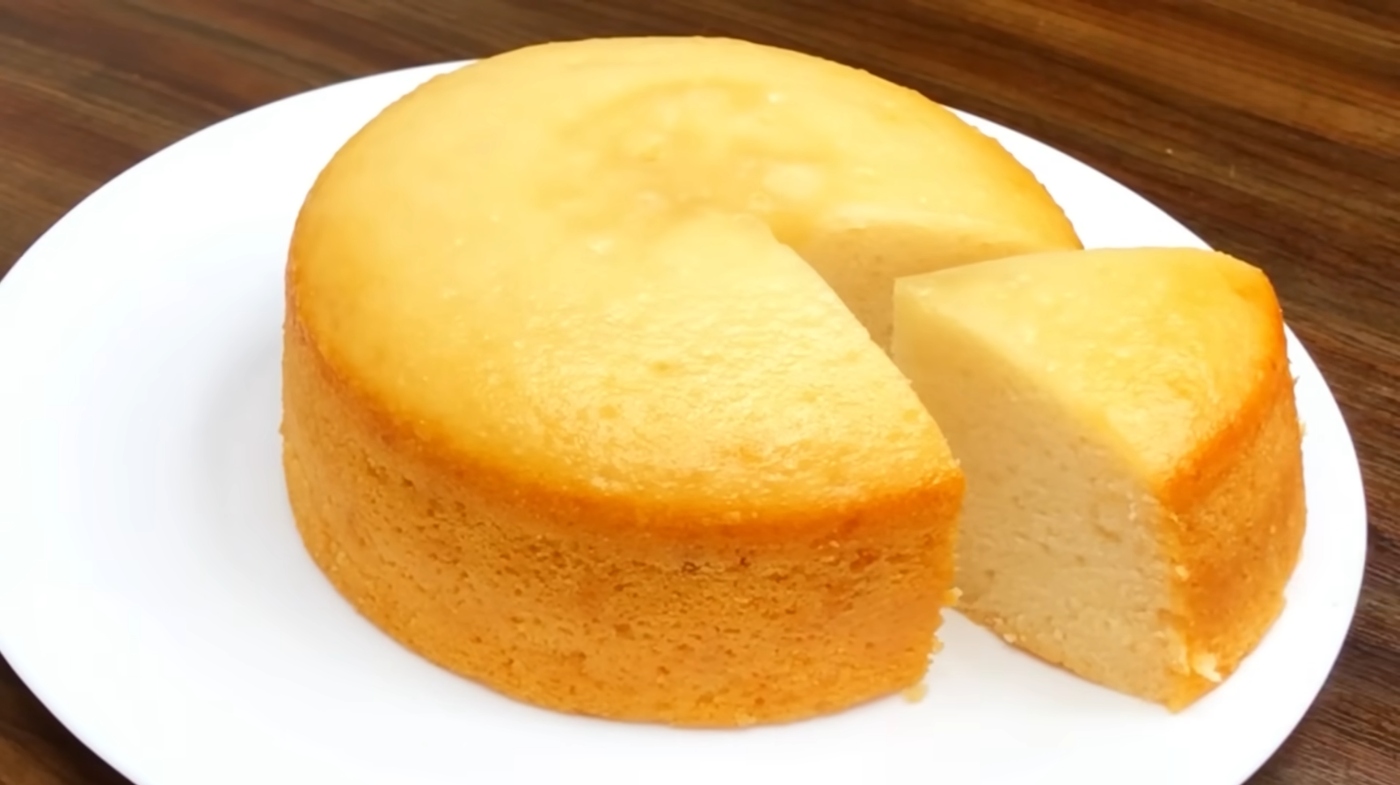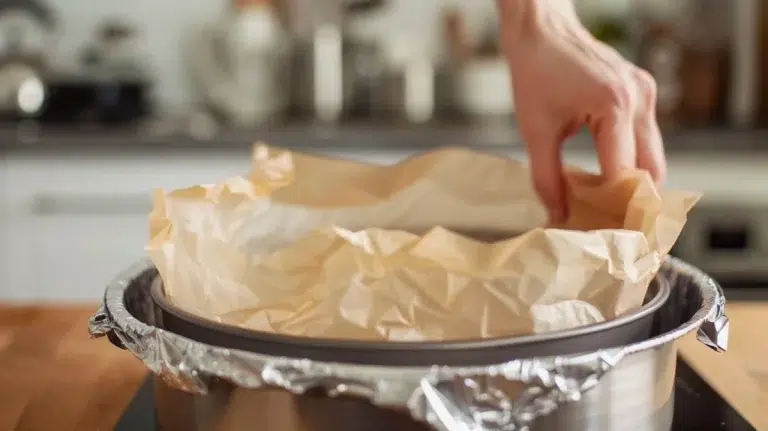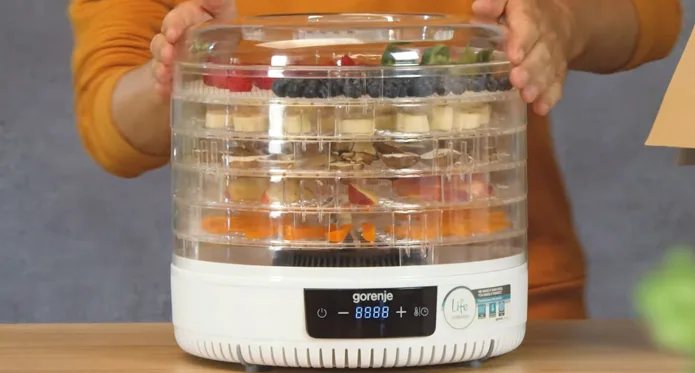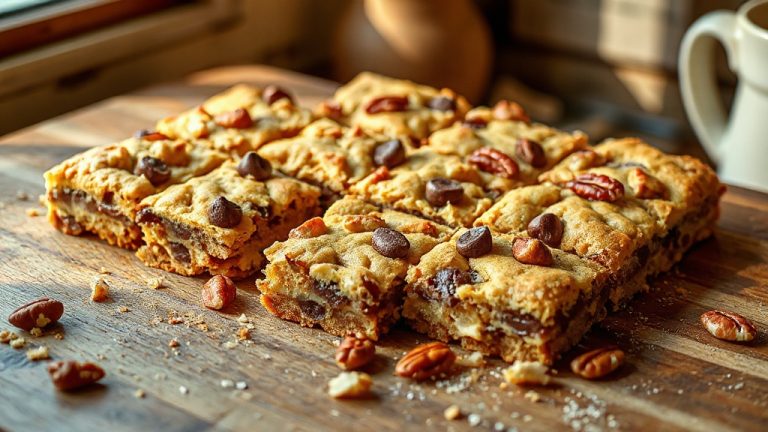Butter Cake Recipe Without Eggs: Easy, Moist, No-Fail Bake
You can make a delicious butter cake without eggs by substituting sweetened condensed milk for moisture and binding.
Start by softening unsalted butter to a creamy consistency, then sift your dry ingredients, including all-purpose flour and baking powder. Mix gently to retain air and combine with condensed milk and vanilla extract for flavor.
Bake at 180°C, adjusting the temperature after 15 minutes for an even crumb. For detailed steps and tips, keep exploring how to perfect your eggless butter cake.
Key Takeaways
- Use sweetened condensed milk (400g) as an egg substitute for moisture, binding, and sweetness in the butter cake recipe.
- Soften 100-250g unsalted butter at room temperature for smooth mixing and a light, fluffy cake texture.
- Combine sifted all-purpose flour, baking powder (1.5-2 tsp), and salt for proper aeration and consistent rise.
- Mix wet and dry ingredients gently, balancing batter consistency with warm milk to avoid deflating the batter.
- Bake at 180°C for 15 minutes, then reduce to 170°C, using the middle oven rack for even cooking.
Butter Cake Recipe Without Eggs: Quick Look Table
| Ingredients | Process |
|---|---|
| 100-250g unsalted butter (softened) | Soften butter at room temperature for 30-45 minutes until pliable but still holding shape. Should leave an indentation when pressed. |
| 400g sweetened condensed milk (1 tin) | Use as primary egg substitute – provides moisture, binding, and sweetness. |
| All-purpose flour (sifted) | Sift flour with baking powder and salt through fine mesh sieve to remove lumps and aerate mixture. |
| 1.5-2 tsp baking powder | Combine with flour for proper leavening and consistent rise. |
| Pinch of salt | Add to dry ingredients for flavor enhancement. |
| 1-2 tsp vanilla extract | Mix with wet ingredients for flavor depth. |
| Warm milk (as needed) | Add gradually to achieve proper dropping consistency. |
Ingredients Needed for Eggless Butter Cake
To make an eggless butter cake, you’ll need specific ingredients that replicate the texture and richness eggs usually provide. Start with unsalted butter, about 100 to 250 grams, softened or melted for easy mixing.
This guarantees a rich, moist texture and the dense, tender crumb typical of butter cakes. Using high-quality, fresh butter is essential for flavor and moisture, such as Lurpak unsalted butter, though salted butter can be used if salt is omitted.
Sweetened condensed milk, roughly one standard tin (400 grams), replaces eggs by adding moisture, sweetness, and binding properties. For flavor, use 1 to 2 teaspoons of vanilla extract or essence to enhance the buttery notes.
Leavening agents like 1.5 to 2 teaspoons of baking powder—and sometimes a bit of baking soda—are essential for aeration, preventing density. Finally, include liquids such as full-fat milk, water, or yogurt to adjust batter consistency and achieve the desired softness in the final cake.
Preparing the Dry Ingredients
Three essential steps guarantee your dry ingredients are perfectly prepared for an eggless butter cake. First, accurately measure all-purpose flour, baking powder, salt, and sugar, then place them in a fine mesh sieve over a clean, dry bowl.
Second, sift the combined dry ingredients thoroughly to remove lumps, aerate the mixture, and distribute leavening agents evenly. If lumps persist, sift again to confirm uniformity.
Third, set the sifted ingredients aside separately to maintain recipe accuracy before mixing with wet components.
Proper preparation prevents dense spots, promotes consistent rising, and improves batter texture. Using a kitchen scale and avoiding over-sifting optimizes results.
It is important to use active baking powder and baking soda to ensure the cake rises well and has a delicate crumb.
How to Soften and Prepare Butter?
Softening butter properly is essential for achieving the ideal texture and rise in your eggless butter cake. Start by leaving butter at room temperature for 30 to 45 minutes in its wrapper to prevent drying.
The butter should feel pliable but still hold its shape—soft enough to leave an indentation when pressed without being oily or melting. Room temperature butter is typically around 65°F (18°C), which is cool enough to handle but soft enough to cream efficiently.
If you’re short on time, use the steam method: place butter in a microwave-safe bowl, cover with a hot-water-heated bowl, and let steam gently soften it. Avoid direct microwaving to prevent melting and separation.
To speed softening, slice butter into thin pats or spread it thinly on a plate. Properly softened butter blends smoothly with sugar, trapping air during creaming to create a tender crumb and even rise in your cake.
Mixing the Batter for Perfect Texture
Start by ensuring your butter is properly softened to create a smooth, airy base for the batter. Use gentle mixing techniques to combine ingredients without deflating the air you’ve incorporated.
It is important to use the cut and fold method when mixing wet and dry ingredients to avoid over-mixing, which can affect the cake’s texture.
Finally, balance the wet and dry components carefully to maintain the batter’s ideal consistency and texture. For best results, use warm milk to achieve the desired dropping consistency for the batter.
Softened Butter Importance
Achieving the perfect butter consistency plays a crucial role in mixing batter for a butter cake with an ideal texture. You should bring butter to room temperature—between 65°F and 72°F—so it’s slightly firm and yields an indent when pressed, without melting.
This softness allows sugar crystals to cut through the fat during creaming, trapping tiny air pockets necessary for rise and a light crumb, especially important in eggless recipes. Avoid overly soft or melted butter, which reduces aeration and leads to dense batter.
To soften evenly, let butter sit at room temperature or flatten it to increase surface area, steering clear of microwaving to prevent hot spots.
Using a rolling pin to flatten butter between parchment paper to about 1/2-inch thick is a quick method to achieve this softened butter. Properly softened butter facilitates smooth emulsification, consistent batter texture, and ultimately, a tender, moist butter cake without eggs.
Gentle Mixing Techniques
When you mix the batter for an eggless butter cake, handling it gently is crucial to preserve the delicate air pockets created during creaming.
Use the creaming method to beat softened butter with condensed milk until light and fluffy. After adding dry ingredients, switch to a cut and fold technique to combine without deflating the batter.
Mix just until ingredients are combined; overmixing leads to toughness, undermixing causes uneven texture. Using condensed milk not only enhances flavor and texture but also aids in aeration of the batter, which is important for the cake’s rise and crumb.
| Step | Tool Used | Purpose |
|---|---|---|
| Creaming | Hand whisk/electric | Incorporate air for leavening |
| Folding dry mix | Rubber spatula | Gentle combination without loss |
| Gradual liquid add | Measuring cups/spoons | Maintain batter cohesion |
| Mixing duration | Timer | Prevent gluten overdevelopment |
Balancing Wet Dry
Three key factors determine the perfect balance between wet and dry ingredients in an eggless butter cake batter: ingredient proportions, leavening agent levels, and mixing technique.
You need to measure butter, milk, and supplementary wet ingredients like condensed milk carefully to achieve a dropping consistency that guarantees even texture.
Leavening agents must be accurately combined with acidic components for proper rise, avoiding dense or collapsed cakes. Using a kitchen scale to measure ingredients accurately can greatly enhance the consistency and quality of your batter.
Follow the correct mixing order—cream butter and condensed milk first, sift and fold in dry ingredients gently, then add warm milk gradually. Avoid overmixing to prevent gluten overdevelopment and preserve air pockets for a tender crumb.
- Maintain room temperature butter for stable creaming
- Sift dry ingredients evenly with leaveners
- Add liquids slowly to adjust batter viscosity
- Fold dry into wet gently to retain air
- Monitor batter using spoon test for ideal consistency
Using Condensed Milk in Eggless Cakes
When you use condensed milk in eggless butter cakes, it acts as both a sweetening and moisturizing agent, reducing the need for extra sugar while keeping the cake tender.
Its rich, creamy texture enhances the cake’s overall mouthfeel and helps maintain softness over time. Additionally, condensed milk subtly boosts flavor, adding a mild caramel note that complements traditional cake ingredients.
The recipe typically includes a combination of baking powder and baking soda to ensure proper cake rising without eggs.
Sweetening and Moisturizing Agent
Since condensed milk combines sweetening and moisturizing properties, it serves as an ideal ingredient in eggless butter cakes. You won’t need extra sugar, as condensed milk delivers uniform sweetness and rich flavor with subtle caramel notes.
Its high moisture content keeps the cake tender and prevents dryness. Condensed milk also aids in binding, enhancing softness and extending freshness. Additionally, a butter-based recipe is recommended to achieve the desired density and richness in the cake.
Remember these key points when using condensed milk in your eggless butter cake:
- Provides concentrated sweetness without graininess
- Retains moisture for a soft, tender crumb
- Boosts buttery, creamy mouthfeel without eggs
- Enhances flavor complexity through Maillard reaction
- Requires precise measurement to maintain ideal texture
Impact on Cake Texture
Condensed milk not only sweetens and moistens your eggless butter cake but also markedly influences its texture. Its high moisture content prevents dryness and promotes a soft, velvety crumb, closely mimicking the moisture eggs provide.
The sugars and fats act as tenderizers, resulting in a buttery mouthfeel and tender bite. Structurally, condensed milk partially replaces eggs’ binding role, enhancing crumb cohesion through a gelatinized matrix formed during baking.
This synergy with leavening agents improves rise and crumb uniformity, though cakes remain denser than traditional egg versions. Its thick consistency thickens the batter, supporting shape retention and reducing crumbliness.
Proper balance with dry ingredients ensures a light crumb and prevents gumminess. Coating chocolate chips with flour is an important step to prevent sinking and maintain even texture throughout the cake.
Flavor Enhancement Benefits
Although eggless cakes lack eggs’ natural sweetness and richness, using condensed milk effectively bridges this gap by enhancing flavor complexity. It delivers a concentrated sweetness that balances the absence of eggs and adds a subtle caramel note, deepening the cake’s taste.
Condensed milk also improves moisture retention, creating a velvety mouthfeel similar to traditional butter cakes. Its stability under heat guarantees consistent flavor throughout baking, making it a reliable ingredient for eggless recipes. Additionally, it pairs well with various flavorings, from citrus zest to spices, amplifying the cake’s sensory appeal.
- Adds concentrated sweetness with natural caramelization
- Enhances moisture and richness for a velvety texture
- Provides stable, uniform flavor under baking heat
- Deepens flavor complexity with buttery and custard undertones
- Versatile with citrus, chocolate, spices, and nuts
Moreover, recipes like the 4-ingredient condensed milk cake demonstrate how this ingredient can produce a moist and fluffy crumb even without eggs, making it ideal for beginners to achieve excellent results with minimal effort (4-ingredient cake).
Baking Instructions and Oven Settings
When you preheat your oven at least 15 minutes before baking, you assure an even heat distribution essential for a well-risen butter cake. Begin baking at 180°C (356°F) for 15 minutes to set the cake structure, then reduce to 170°C (338°F) for gentle cooking.
In convection ovens, maintain 170°C (335°F) throughout. Always place your cake pans on the middle rack to assure balanced heat exposure. It is also important to weigh ingredients in grams for precision to ensure consistent baking results.
| Oven Type | Initial Temp | Reduced Temp |
|---|---|---|
| Conventional | 180°C (356°F) | 170°C (338°F) |
| Convection (Fan) | 170°C (335°F) | 170°C (335°F) |
Bake 28-45 minutes; test doneness with a toothpick. Cool in pan 15-20 minutes before unmolding to prevent damage.
Tips for Achieving a Moist and Tender Crumb
To achieve a moist and tender crumb in your butter cake, you’ll need to focus on the creaming process and ingredient balance.
Start with room temperature butter and sugar, beating them until the mixture is light and fluffy to incorporate air for leavening.
Use moisture-rich substitutes like sweetened condensed milk or yogurt to replace eggs and maintain softness. Castor sugar is preferred over regular granulated sugar for better texture and sweetness.
Additionally, incorporating step-by-step instructions ensures consistent results throughout the baking process.
Mix wet and dry ingredients gently to avoid gluten development, which toughens the crumb. Finally, bake at moderate temperature without overbaking to lock in moisture.
- Cream butter and sugar until pale and fluffy
- Incorporate moisture-rich ingredients like yogurt or condensed milk
- Mix flour slowly on low speed, avoiding overmixing
- Use baking powder for lightness
- Cool cake fully in pan before storing airtight to retain softness
Variations and Flavor Enhancements
Mastering the basic technique of creating a moist and tender butter cake sets the stage for exploring a variety of flavor enhancements and ingredient variations.
Start with vanilla as your classic base, then add chai spices like cinnamon and cardamom for warmth or citrus zest for brightness. Incorporate cocoa powder or melted chocolate for a rich chocolate twist. You can also introduce nut extracts or finely chopped nuts to add texture and subtle nuttiness.
Experiment with alternative sweeteners such as sweetened condensed milk for moisture, powdered sugar for fine crumb, or brown sugar to deepen flavor.
Additionally, consider using regular yogurt as a moistening ingredient, as it helps maintain the cake’s delicate balance and tenderness. For dairy, add heavy cream or milk powder to improve tenderness.
Adjust baking soda and acidic liquids to guarantee proper rise. Finally, cream your butter and sugar thoroughly and fold dry ingredients gently to maintain a light, airy crumb.
Storage and Serving Suggestions
Although eggless butter cakes lack eggs, they still demand careful storage to maintain their moisture and flavor.
Store your cake at room temperature in an airtight container for up to 2-3 days, avoiding humidity and direct sunlight. For longer storage, refrigerate wrapped tightly to prevent drying, then bring it to room temperature before serving. Using an airtight container is essential to trap moisture and prevent the cake from becoming stale.
If you want to freeze the cake, wrap it in plastic and foil, freeze undecorated layers, and thaw slowly to preserve texture.
Serve your cake at room temperature, paired with tea or coffee, and garnish lightly for best results.
- Store airtight at room temperature up to 3 days
- Refrigerate perishable cakes, unwrap before serving
- Freeze undecorated layers, thaw overnight in fridge
- Serve with complementary beverages and fresh fruit
- Use serrated knife for clean slicing and presentation
Frequently Asked Questions
Can I Substitute Butter With a Vegan Alternative in This Recipe?
You can definitely substitute butter with a vegan alternative in your recipe. Choose a vegan butter stick for the closest texture and flavor, using a 1:1 ratio.
If you prefer oils like vegetable or coconut, adjust quantities and expect slight texture changes—solid fats help with structure, while oils increase moistness. Test your recipe, as vegan fats may alter browning and crumb, but they work well overall in baking.
How Do I Adjust Baking Time at High Altitudes?
It’s no coincidence that baking times change with altitude—lower air pressure speeds moisture evaporation and gas expansion, so your cake bakes faster and risks drying out or collapsing.
You’ll want to reduce oven temperature by 15-25°F and start checking doneness 5-10 minutes early. Adding a bit more liquid helps counter dryness, and using a toothpick to test guarantees perfect texture. Adjusting these details keeps your cake moist and tender at high altitudes.
Is It Possible to Make This Cake Gluten-Free?
Yes, you can make the cake gluten-free by substituting wheat flour with a gluten-free all-purpose blend. Use xanthan gum or guar gum to mimic gluten’s structure for proper binding. Adjust leavening agents like baking powder to maintain rise.
Choose appropriate egg substitutes like Greek yogurt or applesauce for moisture. Be mindful of mixing and baking times to avoid dryness. Testing small batches helps you perfect texture and flavor before scaling up.
What Are the Best Tools for Mixing Eggless Cake Batter?
Wondering which tools make mixing eggless cake batter easier? You’ll want large stainless steel bowls for durability and non-reactivity, plus silicone spatulas to scrape and fold gently without deflating the batter.
A plastic whisk helps combine ingredients without overmixing, while an electric hand mixer speeds up blending for dense batters. Don’t forget a sifter to aerate dry ingredients and a kitchen scale to measure precisely—these tools guarantee smooth, light, and well-incorporated batter every time.
Can I Freeze the Eggless Butter Cake for Later Use?
Yes, you can freeze your eggless butter cake for later use. Make sure it’s completely cooled first to avoid moisture buildup. Wrap it tightly in plastic wrap, then foil, to prevent freezer burn and odors.
Freeze for up to 2-3 months, labeling the date. Thaw it in the fridge overnight or at room temperature while wrapped to keep moisture. Avoid microwaving frozen cake to preserve texture and flavor.
No Eggs, No Problem, Just Pure Butter Cake Bliss
So, who knew that skipping eggs could still give you a butter cake that’s just as rich and tender? You’ve mastered softening butter, mixing perfectly, and even using condensed milk to keep things moist—without cracking a single egg.
It’s almost ironic that something ‘missing’ could make your cake so complete. Now, just follow the steps carefully, and you’ll have a delicious eggless butter cake that proves sometimes less really is more.







